SPECIAL
My First Osaka
Collecting Shrine and Temple Stamps on Osaka Metro

2025.02.07
สวัสดี!
I’m Nene. I’m from Thailand. My interest in Japan began in my childhood with my love for Japanese anime and manga. I came to Osaka to go to a university and fell in love with Japanese food, culture…and everything. I’m so happy to be living here.
Today, I took Osaka Metro to visit shrines and temples in Osaka City and experience “Goshuin Meguri” (collecting shrine and temple stamps).

Nene
What are Goshuin Stamps?

What are Goshuin stamps?
Goshuin are seal stamps you receive at a shrine or temple as a proof of your pilgrimage. The red seal is particular to the shrine or the temple visited, and the shrine or temple name is handwritten in ink calligraphy, along with the date of the visit, etc.

For someone like me, these characters written with brush and ink are simply an art. Typically, these are handwritten directly onto the goshuin-cho (goshuin notebook) but some places give you their original washi paper with the seal stamp.
It’s like a stamp rally, you say? Not at all. The most important difference is that goshuin were originally given as a proof that you have copied the sutra and submitted it to the temple. Today, you can receive the goshuin as a proof that you have simply visited the shrine or temple, but it is still a sacred impression. We should behave and show our respect when receiving the goshuin. Do double check before your visit though as some shrines and temples do not give out goshuin.
Umeda: Ohatsu Tenjin (Tsuyu no Tenjinja)

Let’s start our pilgrimage!
I first went to Tsuyunoten Shrine near Umeda Station. It was only about 5 minute walk. Famously known as Ohatsu Tenjin, this shrine is the stage of a famous tragic love story, Sonezaki Shinju (the love suicides at Sonezaki), for the Japanese traditional puppet theater. Naturally, the shrine is known for romantic blessings.

Before I did anything, I purified myself at the basin and went to worship with a peaceful mind.

After I threw my offering into the offertory box, I bowed twice, clapped twice, and bowed once more. Some shrines have a guide to show the proper way to worship with helpful illustrations. Let’s pray.
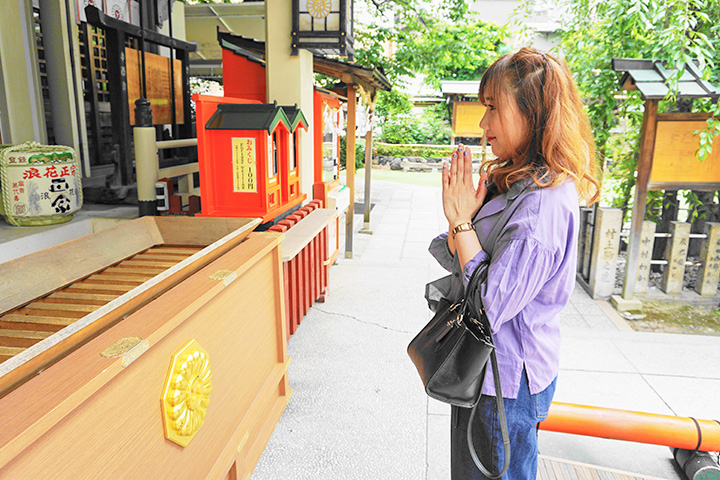
After the worship, visit the Juyojo, literally, “place to receive”, and inquire if you can receive goshuin by saying “Goshuin wo itadake masu ka?” There is a fee to receive goshuin. The typical fee for goshuin is 500 to 1,000 yen and may be called “Hatsuho ryo” (ceremony fee) or “Nokyo ryo” (fee for the colleciton of the hand-copied sutra). Small changes would come in handy for the occasion.
I also purchased a goshuin notebook since I didn’t have one already. The pretty blue notebook has a drawing of the couple from the Sonezaki Shinju story! This notebook cost 2,200 yen and is not included in the Hatsuho ryo above.

I was excited a Kannushi Shinto priest was going to handwrite my goshuin and really wanted to watch, but that’d have been a bit rude. So I waited quietly, with excitement.

Arigato gozaimasu!
Look! Here it is. My first goshuin! Calligraphy is beautiful and exotic.

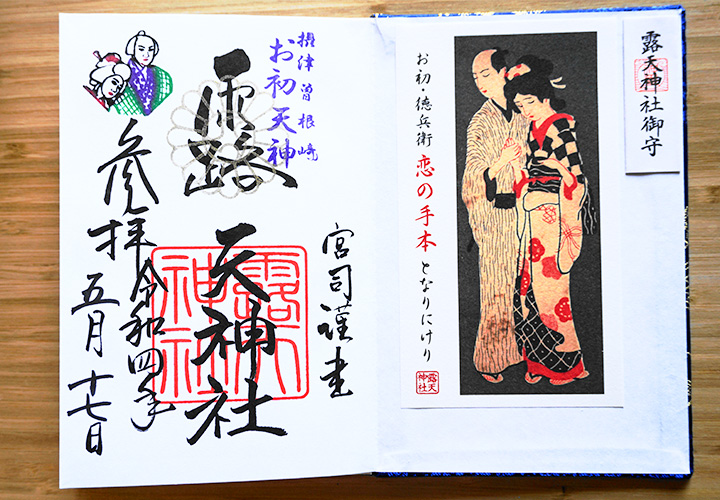
And the illustration of the Sonezaki Shinju couple is romantic. Maybe I’ll find love somewhere after this.
Yodoyabashi: Sukunahikona Shrine

Next I headed to Sukunahikona Shrine located about 6 minute walk from Yodoyabashi Station, just one stop away on the Midosuji Line. It’s also a quick 2 minute walk from Kitahama Station on the Sakaisuji Line. Popularly called “Shinno-san”, Sukunahikona Shrine is known for gods of medicine and health. Be careful–it can be easy to miss as the entrance is sandwiched between buildings in a business district.

The Doshomachi area itself is also known for medicine, with many pharmaceutical companies located here. Medicine has been the commodity in this area since the ancient times, and that is why the guardian deity of Japanese medicine, Sukunahikona no Mikoto, and the guardian deity of Chinese medicine, Emperor Shennong, are enshrined at Sukunahikona Shrine to pray for the safety of drugs and the prosperity of the pharmaceutical industry.
Enshrined in the Main Hall of the shrine is a papier-mache tiger, the shrine’s symbolic amulet to ward off evil and to pray for good health. In the recent years, many have been visiting the shrine to pray for their pets’ health as well.
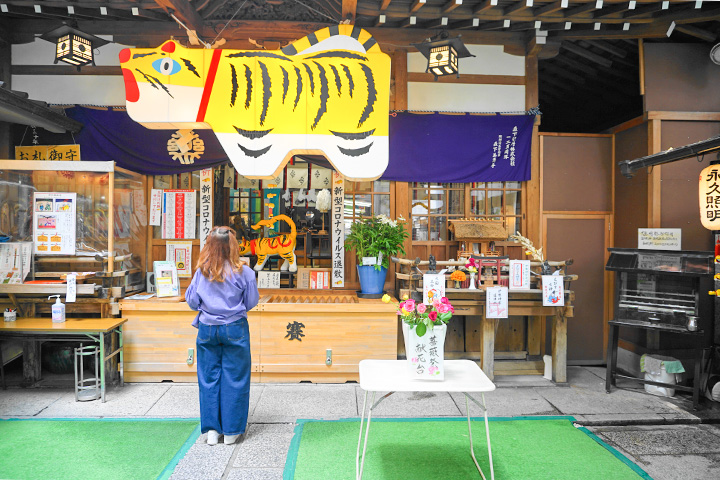
At Sukunahikona Shrine, seasonal goshuin are given out. The one I received had a deisgn of of a beautiful rose, given out only during the month of May. Handmade by the chief priest, the stamp has a gentle color and is very pretty.
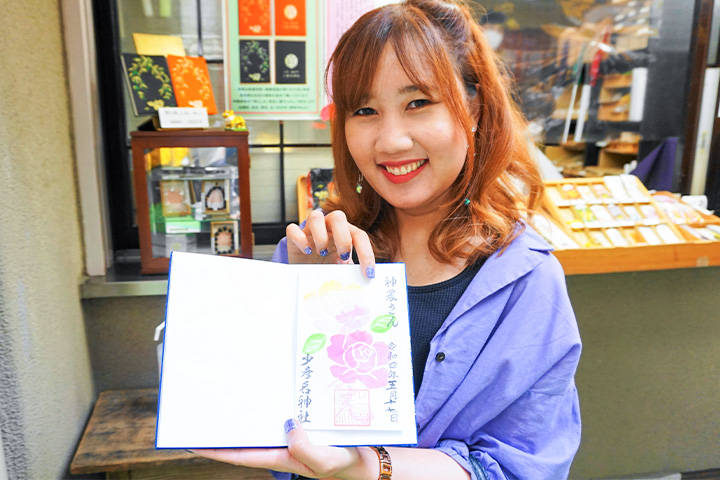
Hommachi: Ikasuri Shrine

I hopped back on the Midosuji Line to go one more station to visit Ikasuri Shrine near Hommachi Station. Locally known as “Zama-san”, the guardian deity of Senba merchants, a god who protects households, are enshrined here. The shrine’s main torii gate is one of the few torii in Japan that hasthree torii connected to make one.

The shrine is also known to be the origin of a common Japanese last name, Watanabe. Who’d have guessed that?!

Their goshuin takes a design of two herons facing each other across a chrysanthemum, which is used in the Imperial Seal of Japan. It symbolizes dignified herons–divine messengers–protecting the chrysanthemum, the imperial household. It’s pretty neat.

Their original goshuin notebook also has a design of herons.

I found lots of hydrangea on the shrine grounds. I bet they make up a beautiful scenery during the rainy season.

Ikasuri Shrine was a nice quiet place among a sea of buildings in Hommachi.

Namba: Hozenji Temple

3-minute walk from Namba Station, we’re now at Hozenji Temple located right by Dotonbori, a famous sightseeing spot in Osaka.

It’s quiet and calm at Hozenji Temple. You’d forget it’s located next to bustling Dotonbori. The famous statue of Mizukake Fudo stands here at the little temple. Visitors make a wish while pouring water on the statue, which is covered in green moss. It’s pretty and mystic.

In addition to Mizukake Fudo (officially Nishimuki Fudomyo-o), Konpira-do and Ohatsu Okami are enshrined here, providing various blessings.

Naturally, the goshuin here has a handsome design of Mizukake Fudo here.

I like it. Mizukake Fudo looks powerful, and I feel protected.
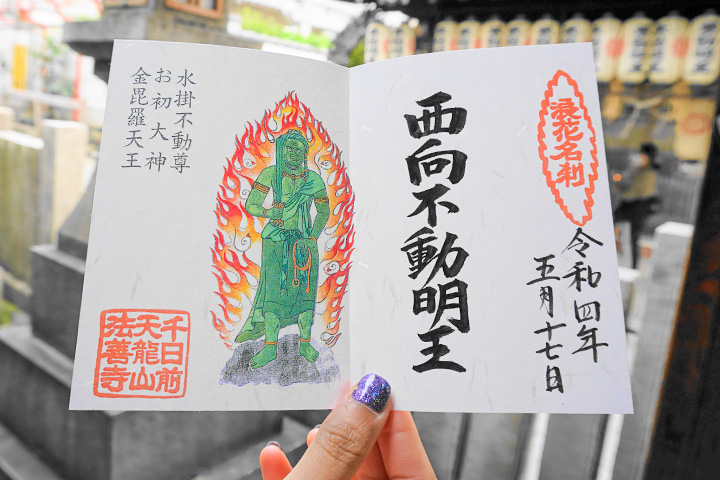
Daikokucho: Namba Yasaka Shrine

My last stop was Namba Yasaka Shrine. The shrine is located about 7 minute walk from Daikokucho Station. Alternatively, you could just walk from Hozenji Temple and that would be a nice 15 minute stroll through the city. Namba Yasaka Shrine is famous for a giant lion head and is a popular photo spot for tourists.
You might have seen a picture of the lion on Instagram or other social media.
Gods here are known for protection from evil and plague, matchmaking, happy marriage, and safe childbirth. It’s also known for victory and winning luck since the large open lion mouth swallows evil spirits. I mean, look at this lion! It’s simply powerful.

At Namba Yasaka Shrine, they will write the calligraphy directly onto your goshuin notebook. It felt special; it was written just for me!

And here is their goshuin notebook featuring–of course–the lion!

The shrine is full of greens. I felt empowered as I left.
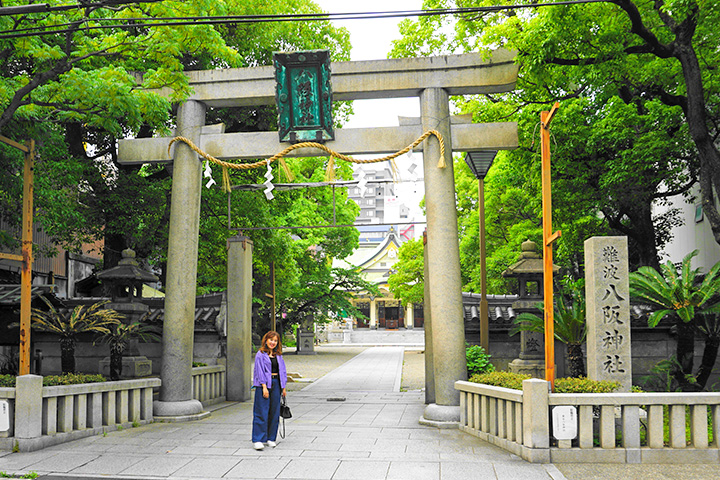
■ Related article
Look At That Lion!Namba Yasaka Shrine
I received goshuin at five different shrines and temples on Osaka Metro’s Midosuji Line today. I feel extremely blessed.
The goshuin notebook is a reminder of the pilgrimage I made today and also serves as nice memorabilia of the trip.
I think I’ll continue to collect goshuin in my special notebook.
I know you can’t resist it either after today♪
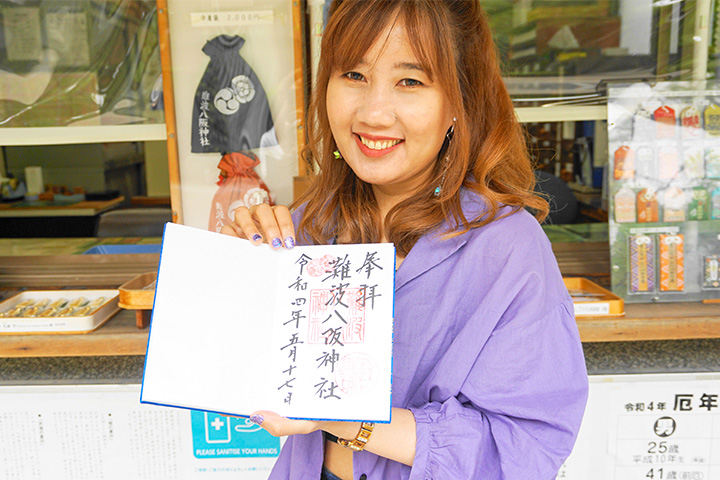
*This information is current as of June 17th, 2022. Please understand that some details may have changed.
Spots Introduced
Tsuyunoten Shrine
[Access] About 3 mins walk from Higashi-Umeda Station Exit No. 7 on the Tanimachi Line
About 5 mins walk from Umeda Station Exit No. 15 on the Midosuji Line
About 9 mins walk from Nishi-Umeda Station Exit No. 6 on the Yotsubashi Line
[Hours] 6:00-24:00
Sukunahikona Shrine
[Access] About 2 mins walk from Exit 6 at Kitahama Station.
About 6 mins walk from Exit 11 at Yodoyabashi Station.
[Hours] Gates open at 7:00am; close at 5:00pm
Ikasuri Shrine
[Access] About 2 mins walk from Exit 15, 21 at Hommachi Station
[Hours] Weekdays 7:30 am - 5:30 pm
Weekends & Holidays 7:30 am - 5:00 pm
Hozenji Temple
[Access] About 3 mins walk from Exit 14 at Namba Station.
About 5 mins walk from Exit 2 at Nippombashi Station, about 11 mins walk from Exit 4-B at Shinsaibashi Station.
Namba Yasaka Shrine
[Access] About 7 mins walk from Exit 32 at Namba Station.
About 7 mins walk from Exit 2 at Daikokucho Station.
Recommended Plans
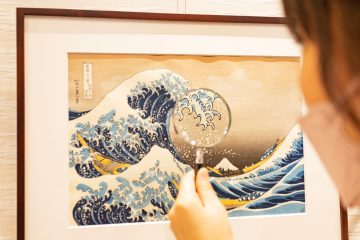
The World of Ukiyo-e:
Japonism that Captured the World
In 17th to 19th century Japan, after the turbulent and violent Warring States period ended, …
2025.06.27

A Must See Summer Festival in Osaka:
The Fantastical Tenjin Matsuri
with Mikoshi, Boats, and Fireworks
The Tenjin Matsuri (Tenjin Matsuri Festival) is one of the biggest festivals in …
2025.06.06

Off-The-Beaten-Track:
A Historic Walk in Tennoji
Many come to Osaka to enjoy food and shopping, but Osaka is also a city with a …
2025.05.30






